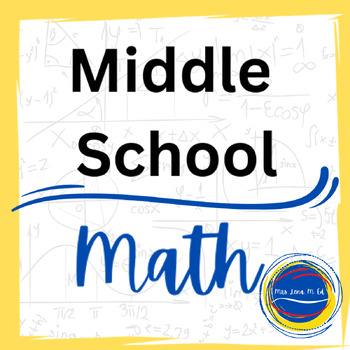Middle School Math Bundle | 168 Pages and Growing
- PDF
- Google Apps™
- Easel Activity

Description
Middle School Math 168 Page Bundle aligned with B.E.S.T. and national standards focuses on fractions, prime factorization, recursive patterns, percents, geometry and integers. Visual, step-by-step, detailed explanations and practice worksheets. Created for instruction, reteaching, Rti, and with visual spatial learners in mind.
1. Greatest Common Factor,
2. Least Common Multiple,
3. Prime Numbers & Prime factorization,
4. Translating numbers from scientific notation into standard form,
5. Adding Fractions (with like and unlike denominators)
6. Adding Mixed Fractions
7. Changing Improper Fractions into Mixed Numbers
8. Adding and subtracting mixed fractions.
9. Subtracting Fractions (with like and unlike denominators)
10. Adding and Subtracting Mixed Numbers with regrouping.
11. Dividing Fractions
12. Multiplying Fractions
13. Recursive Patterns
F.IF.A.3 Recognize that sequences are functions, sometimes defined recursively, whose domain is a subset of the integers.
CC.9.12.B.BF.1 Write a function that describes a relationship between two quantities
MP2: Reason abstractly and quantitatively.
MP4: Model with mathematics.
14. Percents and Fractions
15. Fractions and Decimals
16.Area, Base & Height Of Triangles
17. Integers - Addition and Subtraction
18. Percentage Unit - Grade 7
- finding percent of a number
- finding percent of a whole
- finding fraction of a whole
- finding a percent when given a part and a whole
- finding a whole when given a part and a percent
- finding a percent increase or decrease
19. Probability Unit - Grade 7
- finding probability from experiments
- finding experimental probability
- finding theoretical probability
- tree diagrams
Here’s what teachers just like you are saying about this resource:
⭐️⭐️⭐️⭐️⭐️ Loredana P. says, "Excellent resource!"
⭐️⭐️⭐️⭐️⭐️ Nan E. says, "Thanks for making teaching life easier!"
⭐️⭐️⭐️⭐️⭐️ Kristy P. says, "Excellent for use with our pre assessments"
⭐️⭐️⭐️⭐️⭐️ Mary S. says, "A good additional resource for reviewing fractions with my resource students that are still not getting it consistently."
⭐️⭐️⭐️⭐️⭐️ Ms. Daisy Math says, "Great packet!"
************************************************************************************
• Be sure to FOLLOW MY STORE for NEW PRODUCTS AND SALES >> click here
• Don't forget to leave feedback . You will receive TPT credits to be used towards future purchases!
Happy Teaching!
Mrs. Lena, M.Ed.






